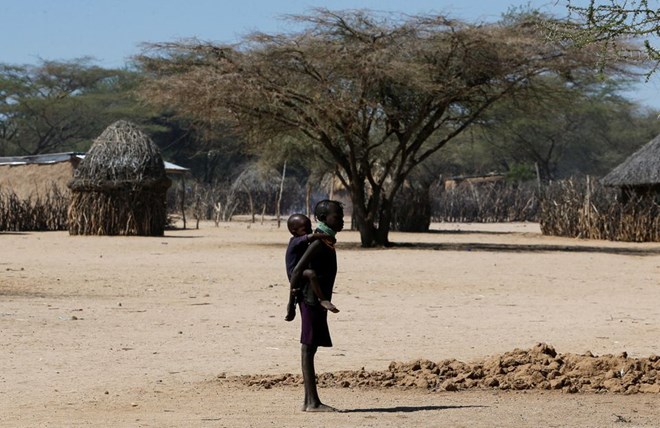
By Jefferson Kahinju
Friday September 30, 2022

A child affected by the worsening drought due to failed rain seasons, carries her sibling as they stand near their makeshift shelter at Sopel village in Turkana, Kenya September 27, 2022. REUTERS/Thomas Mukoya
In a dry river bed in Kenya's arid northwest, pastoralists dig ever-deeper pits in an anxious search for water, as the region suffers its worst drought in 40 years, which has wiped out livestock and crops, deepening a hunger crisis.
For the last four years the annual rains have failed across Kenya, Ethiopia and Somalia and forced 1.5 million people to flee their homes in search of food and water elsewhere.
The impact of hunger is etched on the faces of children filling the "stabilization room" for serious health problems of the Lodwar County and Referral Hospital in northwest Kenya.
"I have three grand-children who have been affected by hunger," said Agnes Ekereru, sitting on a bed with her four-year-old grandson Ekai Ebei. "All my livestock have died because of the drought."
Almost two million children in the Horn of Africa require urgent treatment for life-threatening severe acute malnutrition, according to UNICEF estimates.
The hunger problem is compounded by the war in Ukraine and the fallout from the coronavirus pandemic, which has pushed up the price of cooking oil, bread and wheat flour to record highs at local markets, UNICEF says.
Scientists at the National Aeronautics and Space Administration (NASA) say the drought has been caused by climate change and the La Niña weather pattern in the Pacific Ocean.
Aid groups and authorities predict the next rains in the Horn of Africa are likely to fail too, hurting communities whom a UNICEF official in Kenya said are some of the least responsible for global carbon emissions."It's not the (countries) ironically that are contributing more to that global emission that are paying the heaviest price," said Mohamed Malick Fall, UNICEF regional director for eastern and southern Africa.
"And here comes the notion of equity and justice: why should I pay such a heavy price for something for which I have not contributed so greatly."
With each passing season, the inhabitants of Turkana County, mostly nomadic herders famous for their colourful beadwork and cloth, have fewer resources to fall back on, pushing them closer to the brink.
Earlier this month Kenya's president declared the crisis a national disaster.
"I have lost so much," said Loudi Lokoriyen, a goat-herder searching for water outside the town of Lodwar.
"Close to three hundred (goats) have died, 50 camels have died, and they still continue to die."
Writing by Hereward Holland; Editing by Emelia Sithole-Matarise